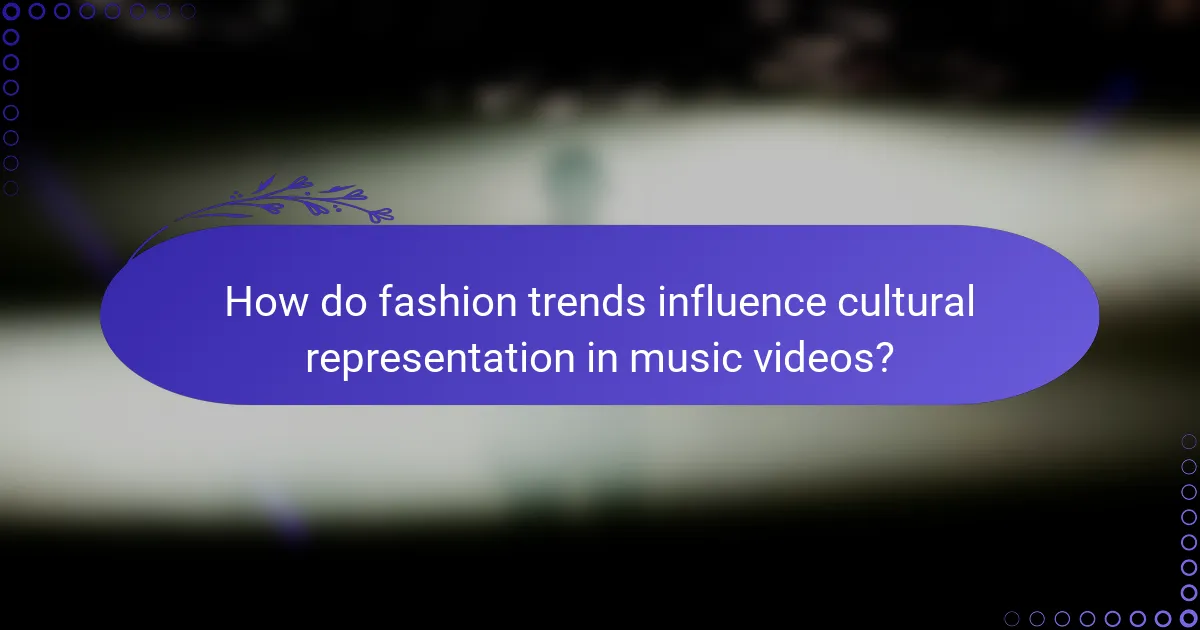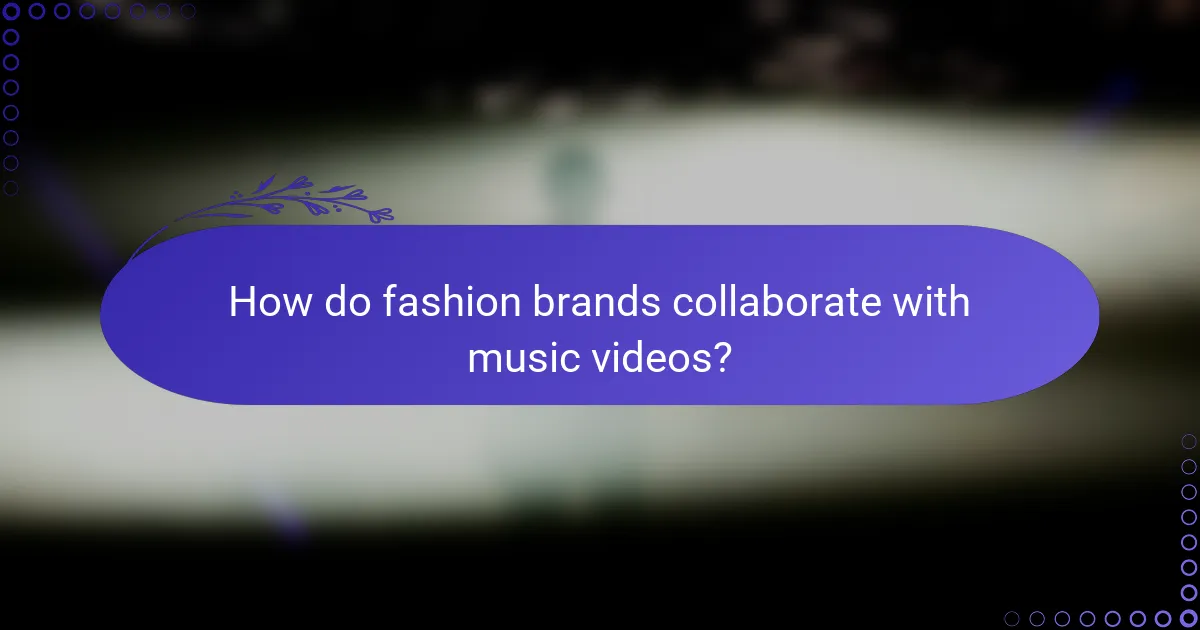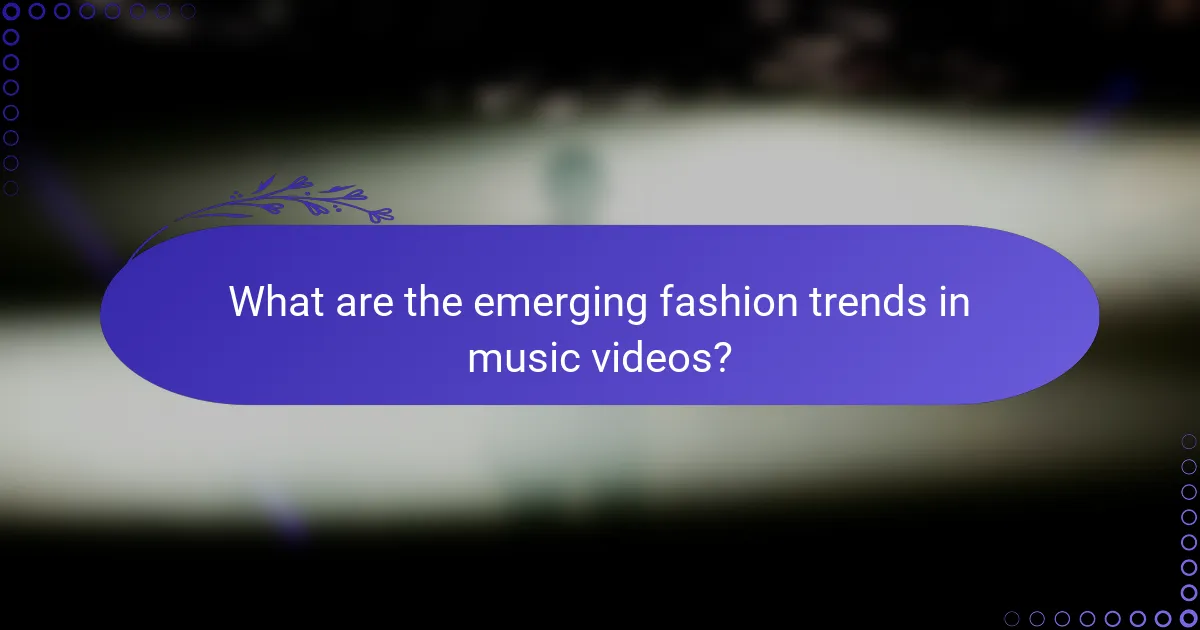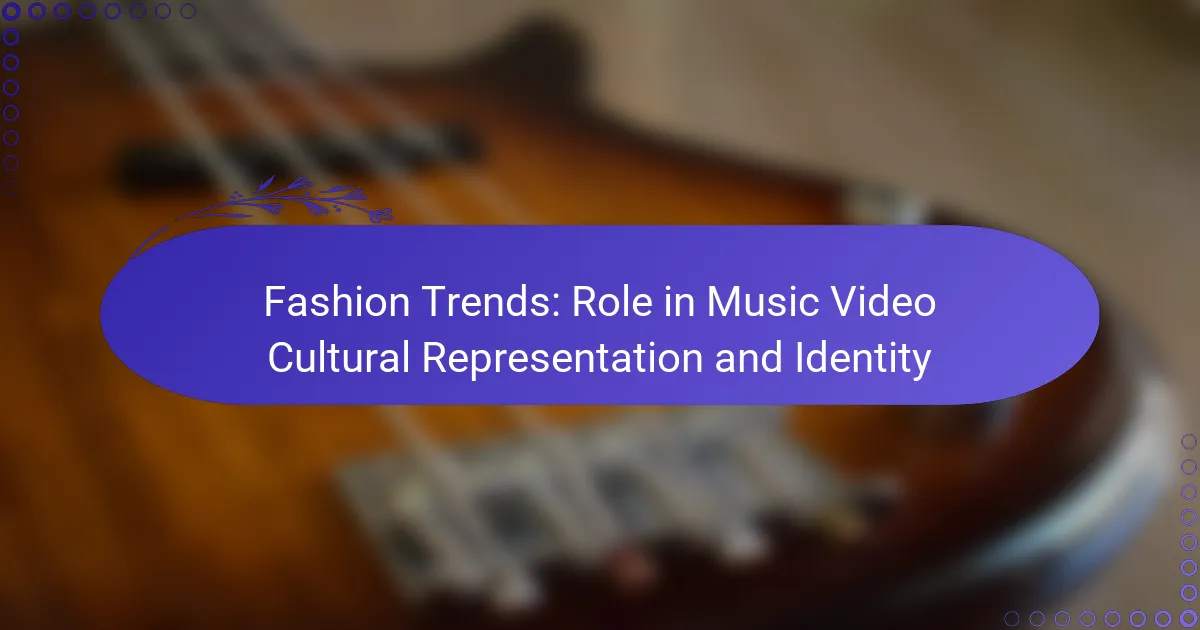Fashion trends are integral to cultural representation in music videos, serving as a powerful medium for artists to express their identities and social messages. Through carefully curated clothing and styling, musicians can connect with audiences, reflecting their cultural backgrounds and personal narratives. This visual language not only enhances artistic expression but also shapes the way identity is perceived within the broader cultural landscape.

How do fashion trends influence cultural representation in music videos?
Fashion trends play a crucial role in shaping cultural representation in music videos by visually conveying identity, social messages, and artistic expression. Through clothing, accessories, and styling, artists can reflect their cultural backgrounds and connect with audiences on deeper levels.
Visual storytelling through fashion
Fashion serves as a powerful tool for visual storytelling in music videos, allowing artists to express themes and narratives without words. For example, vibrant streetwear can signify urban culture, while elegant attire may evoke sophistication and class. The choice of fashion can enhance the overall aesthetic and emotional impact of the video.
Additionally, specific styles can reference historical or cultural movements, creating a layered meaning. For instance, incorporating retro fashion can evoke nostalgia, while contemporary trends might highlight current social issues.
Impact on audience perception
The fashion depicted in music videos significantly influences audience perception of both the artist and the cultural context. Viewers often associate certain styles with particular lifestyles or values, which can enhance or diminish an artist’s credibility. For example, an artist wearing high-end designer labels may be perceived as aspirational, while those in casual, thrifted outfits might resonate with authenticity and relatability.
Moreover, fashion can challenge stereotypes or reinforce them, depending on how it is presented. Artists who embrace diverse styles can promote inclusivity, while those who adhere to conventional norms may inadvertently uphold existing biases.
Case studies of iconic music videos
Several iconic music videos illustrate the impact of fashion on cultural representation. For instance, Beyoncé’s “Formation” features a blend of Southern Black culture and high fashion, showcasing traditional attire alongside modern styles, which empowers and celebrates her heritage.
Another example is Lady Gaga’s “Bad Romance,” where avant-garde fashion choices challenge societal norms and redefine femininity. These videos not only highlight the artists’ identities but also spark conversations about cultural representation and the role of fashion in shaping public perception.

What role does fashion play in shaping identity within music videos?
Fashion significantly influences identity in music videos by visually representing artists’ personas and cultural narratives. It serves as a medium for self-expression, allowing artists to convey their individuality and connect with audiences on a deeper level.
Expression of personal identity
Fashion in music videos often reflects an artist’s personal identity, showcasing their unique style and preferences. For instance, an artist may choose bold colors and avant-garde designs to express confidence and creativity, while another might opt for minimalist aesthetics to convey authenticity.
This personal expression can resonate with fans, encouraging them to adopt similar styles or embrace their own individuality. Artists like Billie Eilish, known for her oversized clothing and distinctive looks, have set trends that inspire fans to explore their personal fashion choices.
Representation of cultural backgrounds
Fashion plays a crucial role in representing cultural backgrounds within music videos, highlighting the diversity of influences that shape an artist’s identity. For example, hip-hop artists often incorporate streetwear that reflects urban culture, while artists from different regions may showcase traditional attire to celebrate their heritage.
This representation fosters a sense of belonging among viewers who identify with the cultural elements portrayed. By wearing clothing that symbolizes their roots, artists can educate audiences about their backgrounds and promote cultural appreciation.
Influence of subcultures
Subcultures significantly impact fashion choices in music videos, as artists often draw inspiration from specific groups. Punk, goth, and rave cultures, for example, have distinct styles that artists may adopt to align themselves with those communities or to challenge mainstream norms.
By integrating elements from these subcultures, artists can create a powerful visual narrative that resonates with like-minded fans. This connection not only reinforces the artist’s identity but also encourages the celebration of diverse subcultural expressions within the broader music scene.

Which artists are known for their fashion-forward music videos?
Several artists are recognized for their innovative and fashion-forward music videos that significantly influence cultural representation and identity. These musicians often use their visual style to convey messages, showcase trends, and reflect their artistic personas.
Beyoncé’s cultural symbolism
Beyoncé’s music videos often incorporate rich cultural symbolism that resonates with her audience. For instance, her visual album “Lemonade” features a blend of African American heritage, feminism, and empowerment, using fashion as a medium to express these themes.
Her choice of designers and styles frequently highlights black-owned brands and traditional garments, reinforcing cultural pride. This approach not only sets trends but also encourages viewers to embrace their identities.
Lady Gaga’s avant-garde style
Lady Gaga is renowned for her avant-garde fashion choices, which often challenge societal norms and expectations. Her music videos, such as “Bad Romance,” showcase outrageous outfits that blur the lines between art and fashion, making bold statements about individuality and self-expression.
Gaga’s collaborations with high-fashion designers like Alexander McQueen and Versace further elevate her visual storytelling, creating a unique aesthetic that captivates audiences and inspires new trends in the fashion industry.
Travis Scott’s brand collaborations
Travis Scott has made a significant impact on the intersection of music and fashion through his brand collaborations. His partnership with Nike, for instance, has resulted in limited-edition sneakers that sell for high prices, reflecting his influence in both the music and fashion worlds.
In his music videos, Scott often showcases streetwear brands and his own merchandise, creating a distinct visual identity that resonates with his fanbase. This strategy not only promotes his music but also positions him as a trendsetter in contemporary fashion.

How do fashion brands collaborate with music videos?
Fashion brands collaborate with music videos primarily through product placements and partnerships with artists, enhancing both visibility and cultural relevance. These collaborations create a dynamic platform where fashion and music intersect, allowing brands to reach wider audiences through engaging visual storytelling.
Product placements in music videos
Product placements in music videos involve strategically featuring fashion items within the video’s narrative or aesthetic. This method allows brands to showcase their products in a context that resonates with viewers, often leading to increased brand recognition and desirability.
For example, a popular artist wearing a specific designer’s outfit can create a buzz, prompting fans to seek out similar styles. Such placements can be subtle, like a logo on clothing, or more prominent, featuring entire outfits that define the artist’s look.
Fashion partnerships with artists
Fashion partnerships with artists often involve collaborations where designers create exclusive pieces for music videos or performances. These partnerships can elevate an artist’s image while providing designers with a platform to showcase their work to a broader audience.
Brands may engage in co-branding efforts, where the artist’s personal style influences the fashion line, creating a unique identity that appeals to fans. Successful partnerships can lead to limited-edition collections that generate excitement and urgency among consumers.
Impact on brand visibility
The impact on brand visibility from collaborations with music videos can be significant, often resulting in increased social media engagement and sales. When a fashion item is featured in a high-profile video, it can lead to spikes in online searches and purchases.
Brands should consider the demographics of the artist’s fanbase, as aligning with popular artists can enhance visibility among target audiences. However, it’s crucial to ensure that the partnership feels authentic to avoid backlash from consumers who value genuine representation in fashion and music.

What are the emerging fashion trends in music videos?
Emerging fashion trends in music videos often reflect broader cultural shifts and the evolving identities of artists. These trends can range from sustainable practices to digital innovations, significantly influencing how fashion is perceived and consumed in popular culture.
Sustainable fashion choices
Sustainable fashion is gaining traction in music videos as artists aim to promote environmental awareness. This includes using eco-friendly materials, supporting ethical brands, and showcasing vintage or upcycled clothing. For example, some artists feature outfits made from organic cotton or recycled fabrics, appealing to environmentally conscious fans.
When incorporating sustainable fashion, consider collaborating with brands that prioritize ethical practices. This not only enhances the video’s message but also aligns the artist’s image with values that resonate with a growing audience concerned about climate change.
Digital fashion in virtual music videos
Digital fashion is becoming increasingly popular in virtual music videos, where artists can showcase outfits that exist solely in the digital realm. This trend allows for limitless creativity, enabling designers to create unique, fantastical garments that would be impossible to produce physically. Virtual concerts and music videos often feature these digital outfits, enhancing the visual experience.
To effectively use digital fashion, artists should collaborate with digital designers and explore platforms that specialize in virtual clothing. This approach not only sets them apart but also engages a tech-savvy audience familiar with virtual realities and gaming environments.
Inclusivity in fashion representation
Inclusivity in fashion representation is crucial in music videos, reflecting diverse identities and body types. Artists are increasingly showcasing a range of styles that cater to various cultural backgrounds, gender identities, and sizes. This trend promotes acceptance and challenges traditional beauty standards, making fashion more accessible to a broader audience.
To embrace inclusivity, artists should work with stylists and brands that celebrate diversity. Highlighting models and performers from different backgrounds in music videos can foster a sense of belonging and empower fans to express their unique identities through fashion.

How do music videos reflect societal changes in fashion?
Music videos serve as a mirror to societal changes in fashion by showcasing evolving styles that resonate with current cultural sentiments. They often highlight trends that reflect broader social movements, influencing how audiences perceive identity and representation.
Response to cultural movements
Music videos frequently respond to significant cultural movements, capturing the essence of societal shifts through fashion. For instance, the rise of streetwear in the 2010s paralleled movements advocating for social justice, with artists using their platforms to promote inclusivity and diversity in style.
Additionally, fashion choices in music videos can signal solidarity with various causes. For example, artists wearing clothing from marginalized designers or brands that support ethical practices can amplify messages of social responsibility and cultural awareness.
Evolution of gender norms in fashion
The evolution of gender norms is prominently reflected in music video fashion, where traditional boundaries are increasingly blurred. Artists are now embracing androgynous styles, challenging conventional notions of masculinity and femininity. This shift encourages audiences to explore their own identities beyond societal expectations.
Moreover, music videos often showcase a diverse range of gender expressions, from bold makeup choices to unconventional clothing. This representation not only validates individual identities but also promotes acceptance and understanding within the broader culture, influencing fashion trends across various demographics.
